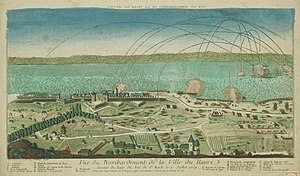
Edward Hawke, 1st Baron Hawke,, of Scarthingwell Hall in the parish of Saxton with Scarthingwell, near Tadcaster, Yorkshire, was a Royal Navy officer. As captain of the third-rate HMS Berwick, he took part in the Battle of Toulon in February 1744 during the War of the Austrian Succession. He also captured six ships of a French squadron in the Bay of Biscay in the Second Battle of Cape Finisterre in October 1747.
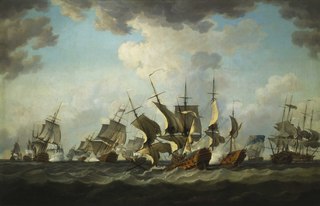
The Battle of Quiberon Bay was a decisive naval engagement during the Seven Years' War. It was fought on 20 November 1759 between the Royal Navy and the French Navy in Quiberon Bay, off the coast of France near Saint-Nazaire. The battle was the culmination of British efforts to eliminate French naval superiority, which could have given the French the ability to carry out their planned invasion of Great Britain. A British fleet of 24 ships of the line under Sir Edward Hawke tracked down and engaged a French fleet of 21 ships of the line under Marshal de Conflans. After hard fighting, the British fleet sank or ran aground six French ships, captured one and scattered the rest, giving the Royal Navy one of its greatest victories, and ending the threat of French invasion for good.
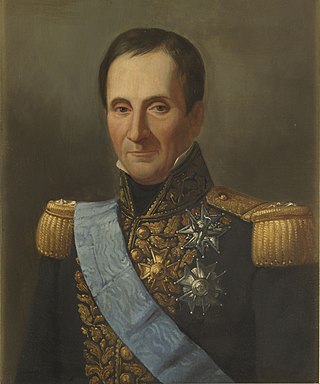
Édouard-Thomas de Burgues, comte de Missiessy was a French naval officer and admiral. He joined the navy in April 1766, as a volunteer aboard his father's ship and spent most of his early service in the Mediterranean, in the frigates of the Toulon Fleet. When France entered the American Revolutionary War, Missiessy joined the 64-gun Vaillant in Admiral d'Estaing's fleet, where he took part in the initial engagements off Newport, St Lucia and Grenada, and in September 1779, the failed attack on Savannah. Missiessy's first command came in 1782 when he was promoted to lieutenant de vaisseau of the cutter Le Pygmée. He was soon after captured by the British but later released in an exchange of prisoners.

Admiral Sir William Sidney Smith was a British Royal Navy officer. Serving in the American and French revolutionary wars and Napoleonic Wars, he rose to the rank of Admiral.
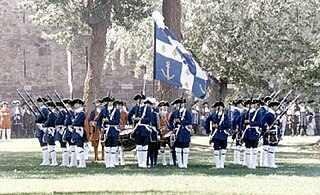
The Troupes de la Marine was a French military formation founded by Cardinal Richelieu in 1622. It was under the denomination of Compagnie ordinaire de la mer, originally intended to form the garrisons of the ships of the King. It was in 1674 that Jean-Baptiste Colbert decided to make permanent colonial troops and give them the name of Compagnies Franches de la Marine.
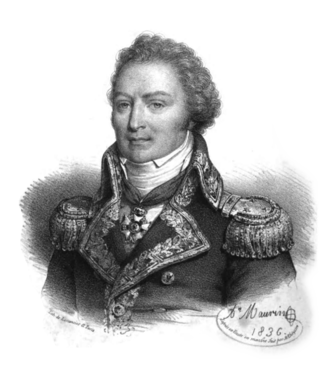
Louis-René Madelaine Le Vassor, comte de La Touche-Tréville was a French admiral. He fought in the American War of Independence and became a prominent figure of the French Revolutionary Wars and of the Napoleonic wars.

The naval Battle of Lagos took place between a British fleet commanded by Edward Boscawen and a French fleet under Jean-François de La Clue-Sabran over two days in 1759 during the Seven Years' War. They fought south west of the Gulf of Cádiz on 18 August and to the east of the small Portuguese port of Lagos, after which the battle is named, on 19 August.

Vice-Admiral Count Pierre Étienne René Marie Dumanoir Le Pelley was a French Navy officer, best known for commanding the vanguard of the French fleet at the Battle of Trafalgar. His conduct during this battle was the subject of controversy.

Vice-Admiral Sir Joshua Rowley, 1st Baronet was a Royal Navy officer who was the fourth son of Admiral Sir William Rowley. Sir Joshua was from an ancient English family, originating in Staffordshire (England) and was born on 1 May 1734. Rowley served with distinction in a number of battles throughout his career and was highly praised by his contemporaries. Unfortunately whilst his career was often active he did not have the opportunity to command any significant engagements and always followed rather than led. His achievements have therefore been eclipsed by his contemporaries such as Keppel, Hawke, Howe and Rodney. Rowley however remains one of the stalwart commanders of the wooden walls that kept Britain safe for so long.

The French expedition to Ireland, known in French as the Expédition d'Irlande, was an unsuccessful attempt by the French Republic to assist the outlawed Society of United Irishmen, a popular rebel Irish republican group, in their planned rebellion against British rule during the French Revolutionary Wars. The French intended to land a large expeditionary force in Ireland during the winter of 1796–1797 which would join with the United Irishmen and drive the British out of Ireland. The French anticipated that this would be a major blow to British morale, prestige and military effectiveness, and was also intended to possibly be the first stage of an eventual invasion of Great Britain itself. To this end, the Directory gathered a force of approximately 15,000 soldiers at Brest under General Lazare Hoche during late 1796, in readiness for a major landing at Bantry Bay in December.
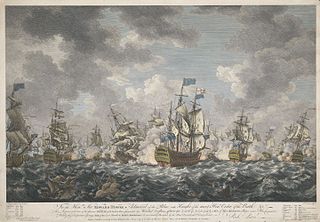
A French invasion of Great Britain was planned to take place in 1759 during the Seven Years' War, but due to various factors was never launched. The French planned to land 100,000 French soldiers in Britain to end British involvement in the war. The invasion was one of several failed French attempts during the 18th century to invade Britain.

An invasion of Great Britain was planned by France in 1744 shortly after the declaration of war between them as part of the War of the Austrian Succession. A large invasion force was prepared and put to sea from Dunkirk in February 1744, only to be partly wrecked and driven back into harbour by violent storms. Deciding that circumstances were not favourable to an invasion, the French government suspended the attempt, and deployed their forces elsewhere.

The Trafalgar campaign was a long and complicated series of fleet manoeuvres carried out by the combined French and Spanish fleets; and the opposing moves of the Royal Navy during much of 1805. These were the culmination of French plans to force a passage through the English Channel, and so achieve a successful invasion of the United Kingdom. The plans were extremely complicated and proved to be impractical. Much of the detail was due to the personal intervention of Napoleon, who as a soldier rather than a sailor failed to consider the effects of weather, difficulties in communication, and the Royal Navy. Despite limited successes in achieving some elements of the plan the French commanders were unable to follow the main objective through to execution. The campaign, which took place over thousands of miles of ocean, was marked by several naval engagements, most significantly at the Battle of Trafalgar on 21 October, where the combined fleet was decisively defeated, and from which the campaign takes its name. A final mopping up action at the Battle of Cape Ortegal on 4 November completed the destruction of the combined fleet, and secured the supremacy of the Royal Navy at sea.

Admiral Pierre André de Suffren de Saint Tropez, bailli de Suffren was a French naval officer and nobleman. Beginning his career during the War of the Austrian Succession, he fought in the Seven Years' War, where he was taken prisoner at the Battle of Lagos. Promoted to captain in 1772, he was one of the aids of Admiral d'Estaing during the Naval battles of the American Revolutionary War, notably taking part in the Siege of Savannah.
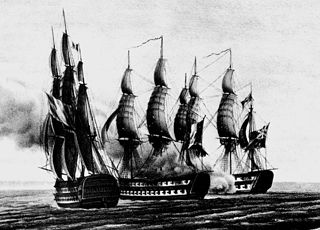
Ganteaume's expeditions of 1801 were three connected major French Navy operations of the spring of 1801 during the French Revolutionary Wars. A French naval squadron from Brest under Contre-amiral Honoré Ganteaume, seeking to reinforce the besieged French garrison in Ottoman Egypt, made three separate but futile efforts to reach the Eastern Mediterranean. The French army in Egypt had been trapped there shortly after the start of the Napoleonic campaign in Egypt in 1798, when the French Mediterranean Fleet was destroyed at the Battle of the Nile. Since that defeat, the French Navy had maintained only a minimal presence in the Mediterranean Sea, while the more numerous British and their allies had succeeded in blockading and defeating several French bases almost unopposed.

The Algeciras campaign was an attempt by a French naval squadron from Toulon under Contre-Admiral Charles Linois to join a French and Spanish fleet at Cadiz during June and July 1801 during the French Revolutionary Wars prior to a planned operation against either Egypt or Portugal. To reach Cadiz, the French squadron had to pass the British naval base at Gibraltar, which housed the squadron tasked with blockading Cadiz. The British squadron was commanded by Rear-Admiral Sir James Saumarez. After a successful voyage between Toulon and Gibraltar, in which a number of British vessels were captured, the squadron anchored at Algeciras, a fortified port city within sight of Gibraltar across Gibraltar Bay. On 6 July 1801, Saumarez attacked the anchored squadron, in the First Battle of Algeciras. Although severe damage was inflicted on all three French ships of the line, none could be successfully captured and the British were forced to withdraw without HMS Hannibal, which had grounded and was subsequently seized by the French.

The Raid on Genoa was a minor naval engagement fought in the harbour of the Italian city of Genoa during the first year of the French Revolutionary Wars. French Republican forces in the Mediterranean, under pressure from Austrian and Spanish armies, Royalist uprisings and British blockade had suffered the loss of their principal naval base and the fleet stationed there when British forces under Lord Hood seized Toulon at the invitation of the city's Royalist faction. The survivors of the French fleet were scattered across the Mediterranean, several sheltering in neutral Italian harbours, including the frigates Modeste at Genoa and Impérieuse at Leghorn.

The action of 24 March 1811 was a minor naval engagement of the Napoleonic Wars, fought as part of the Royal Navy blockade of the French English Channel ports. By 1811, Royal Navy control of the French coast was so entrenched that French ships were unable to travel safely even in French territorial waters. In late 1810, French frigates Elisa and Amazone sailed from Le Havre to join with a larger squadron at Cherbourg-en-Cotentin, but were intercepted by a British frigate squadron and forced to shelter at Saint-Vaast-la-Hougue. There they came under sustained attack and Elisa was destroyed, Amazone successfully slipping back to Le Havre under cover of darkness. To prevent Amazone from escaping once more, the British blockade squadron was reinforced.
HMS Roebuck was a 44-gun, fifth-rate sailing warship of the Royal Navy which carried a main battery of twenty 18-pounder (8.2 kg) long guns. Launched on 21 December 1743, she first served in the English Channel during the War of the Austrian Succession, which Britain entered the following March.

HMS Melpomene was a 38-gun frigate of the Royal Navy. Originally a French vessel, she was captured at Calvi on 10 August 1794 and first saw British service in the English Channel, where she helped to contain enemy privateering. In October 1798, she chased a French frigate squadron sent to find the French fleet under Jean-Baptiste-François Bompart, that was routed at the Battle of Tory Island and in August 1799, she joined Andrew Mitchell's squadron for the Anglo-Russian invasion of Holland.
